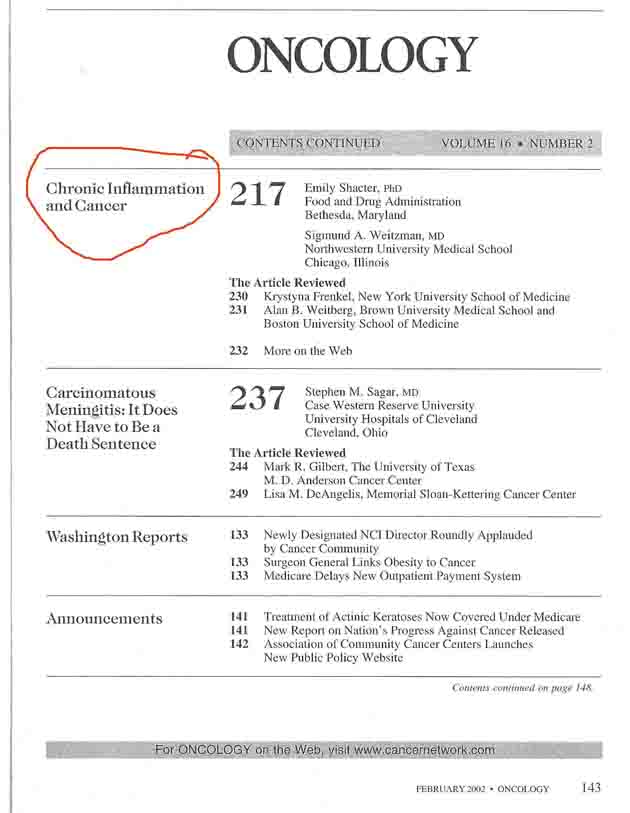
____________________________________________________________________________________________________________________________________________
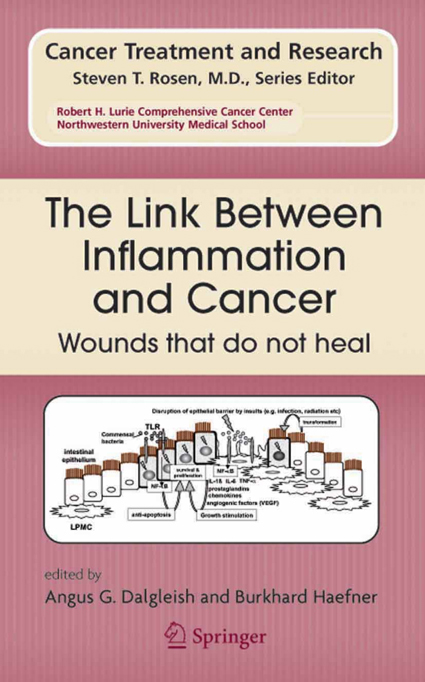
____________________________________________________________________________________________________________________________________________
http://www.cnio.es/eventos/descargas/CCC/240535_1138,46_booklet.pdf
__________________________________________
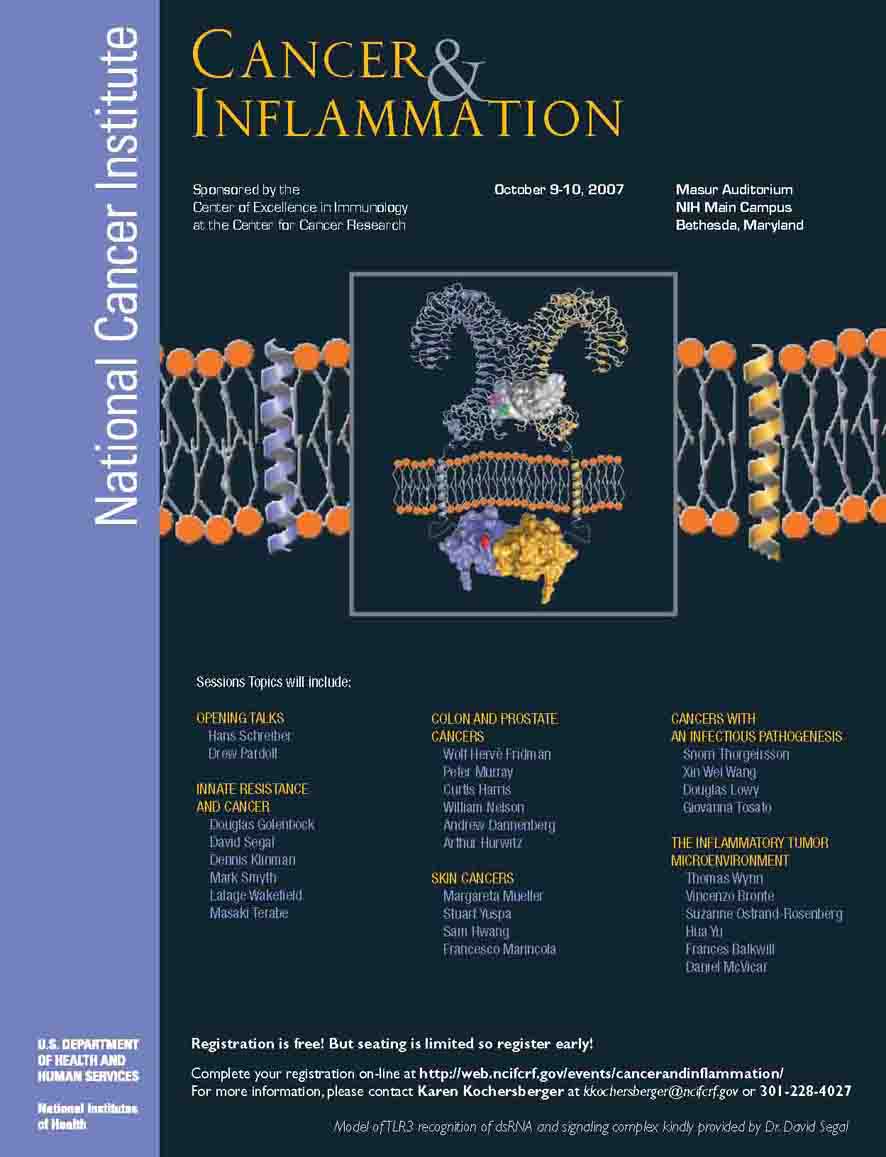
http://web.ncifcrf.gov/events/cancerandinflammation/CancerandInflammation.pdf
http://web.ncifcrf.gov/events/cancerandinflammation/
http://www.cancer.gov/newscenter/pressreleases/InflammationMeeting
__________________________________________
http://cancerres.aacrjournals.org/cgi/reprint/65/19/8583
1 Division of Gastroenterology, Departments of Medicine and Cancer Biology, Vanderbilt University School of Medicine; 2 Department of Veterans Affairs Medical Center, Nashville, Tennessee; and 3 Tumor Biology and Metastasis Branch, Division of Cancer Biology, National Cancer Institute, NIH, Bethesda, Maryland
Requests for reprints: Richard M. Peek, Jr., Division of Gastroenterology, Department of Medicine, Vanderbilt University School of Medicine, 1161 21st Avenue South, C-2104 Medical Center North, Nashville, TN 37232-2279. Phone: 615-322-5200; Fax: 615-343-6229; E-mail: richard.peek@vanderbilt.edu.
__________________________________________________
http://dcb.nci.nih.gov/thinktank/Executive_Summary_of_Inflammation_and_Cancer_Think_Tank.cfm
==================================================
http://www.springer.com/west/home/medicine/oncology?SGWID=4-10073-22-81597188-0
Wounds that do not heal Series: Cancer Treatment and Research , Vol. 130 Dalgleish, Angus; Haefner, Burkhard (Eds.) ISBN: 978-0-387-26282-6
__________________________________________________________________
Cancer and Inflammation, No. 256
Chronic inflammation predisposes to some
forms of cancer and the host response to malignant disease shows several
parallels with inflammation and wound healing. The cells involved in
inflammation are detected in a range of common cancers, together with the
inflammatory cytokines and members of the chemokine ligand/receptor systems.
Neutralization or deletion of the gene for some inflammatory cytokines confers
resistance to tumour induction and experimental metastasis. Over-expression of
such cytokines in tumour cells may enhance malignant potential. Certain
chemokines are likely to subvert antitumour immunity by favouring development of
ineffective Type 2 responses. Tumour cells may even utilize chemokine receptors
in homing to lymph nodes and other organs. Thus, the cells, cytokines and
chemokines found in tumours are more likely to contribute to tumour growth,
progression and immunosuppression than they are to mount an effective host
antitumour response.
This book draws together contributions from an international group of scientists
and clinicians from diverse disciplines, ranging from epidemiology to
immunology, cell biology, molecular oncology, molecular medicine and
pharmacology to debate these and related issues. Topics covered include the
epidemiological links between cancer and inflammation, the parallels between
inflammation and cancer, the role of inflammation in cancer, inflammatory genes
as risk factors for cancer initiation and progression, inflammation and cancer
angiogenesis, and preventative and therapeutic strategies.
http://eu.wiley.com/WileyCDA/WileyTitle/productCd-047085510X.html
http://media.wiley.com/product_data/coverImage300/26/04708567/0470856726.jpg
__________________________________________________________________
http://www.supportiveoncology.net/journal/articles/0504164.pdf
PEER VIEWPOINTS
Inflammation and Cancer: From Bench to Bedside?
Alberto Mantovani, MD, Antonio Sica, PhD, and Paola Allavena, MD, Istituto
Clinico Humanitas and University of Milan, Rozzano, Milan, Italy
____________________________________________
http://www.the-scientist.com/article/display/15898/
Cancer Research in Flames
Tracking inflammation's role in promoting malignancy could lead to better
treatments by Michael Karin
The Scientist 2005, 19(23):24
Published 5 December 2005
One problem with the current war on cancer is that much of it focuses on
destroying the malignant cell itself while paying little attention to some of
cancer's allies that are more prone to attack.
_____________________________________________
http://plan2005.cancer.gov/discovery.html
May Provide Secondary Benefits for Cancer
Nearly 150 years ago, the German physician Rudolph Virchow first proposed a connection between inflammation and cancer. Noting that cancerous tissue also contains the cells and factors that are hallmark features of the body's inflammatory response, Virchow hypothesized that cancer begins at sites of chronic inflammation. At the time - and for many years to follow - the scientific community disavowed this idea because few could envision how the body's first line of defense against tissue injury and infection could also cause harm.
Over the past decade, however, scientists have uncovered increasing evidence to support Virchow's claim. They have determined that the very factors recruited by the body to prevent infection and encourage healing at an injured site can misfire and produce damage. And, if the triggering bacteria, virus, or chemical irritant lingers in the body, a state of chronic inflammation can arise.
Today, research indicates that chronic inflammation underpins a host of diseases, including cancer:
But the most established and elucidated connection between chronic inflammation and cancer is with colorectal cancer.
Drug Therapy Establishes the Link
Evidence supporting a link between chronic inflammation and colon cancer came
together from multiple paths of scientific discovery. For years, scientists
observed that patients with long-term chronic inflammatory bowel disease, a
group of disorders causing chronic and recurring inflammation of the intestines,
often develop colorectal cancer. Population studies confirmed this association.
At the same time, scientists studying the effects of non-steroidal anti-inflammatory drugs (NSAIDs) were also finding evidence to support this link. NSAIDs, which include aspirin, are among the oldest and most widely used drugs in history.
The weight of this collective evidence prompted various research teams throughout the country to explore how NSAIDs act on the body and how this action results in reduced polyp growth and colon cancer risk.
The Search for a Common Thread
With a chemically diverse group of drugs like NSAIDs sharing the same
therapeutic qualities and adverse side effects, it was assumed that they also
share a common mode of action. The activity of these drugs was determined in
1971 when Dr. John Vane and his colleagues demonstrated that aspirin and all
NSAIDs restrict inflammation by inhibiting the body's production of
prostaglandins. Vane predicted that NSAIDs
accomplish this outcome by blocking the activity of the cyclooxygenase (COX)
enzyme, which catalyzes a key step in prostaglandin synthesis.
Vane's Nobel Prize-winning discovery paved the way for future studies confirming the role of COX enzymes in prostaglandin production, and ultimately for the development of drugs that treat inflammatory diseases by blocking the activity of the enzymes. At first, scientists knew of only one COX enzyme. In 1990, however, three research teams became interested in a protein produced by cells that were becoming cancerous.
Scientists recognized that NSAIDs reduce inflammation by blocking the actions of the COX-2 protein, making them potent treatments for inflammation-associated diseases like arthritis. But they still did not have the findings to document why these anti-inflammatory agents reduce colorectal cancer risk. In 1994, a key piece to this puzzle - the link between COX-2 and colorectal tumors - was provided by Charles Eberhart and Raymond DuBois, who observed that COX-2 (but not COX-1) levels are elevated in as many as 80 percent of colorectal tumors. This finding, since replicated by animal studies, suggests a role for COX-2 and inflammation in tumor development.
Promising Therapies and Future Paths
The potential of NSAIDs as chemoprevention agents for colon cancer is
considerably limited by the fact that these drugs can cause serious adverse
effects. Because they block the actions of both COX proteins, dosing can lead to
excessive stomach acid production, ulceration, and gastrointestinal bleeding.
Scientists thought that a better chemoprevention drug would need to selectively target only the COX-2 enzyme, thereby reducing the most harmful effect of NSAIDs while capitalizing on their benefits. In a milestone NCI-sponsored cancer prevention trial, researchers reported on such a drug, celecoxib, an arthritis medicine that selectively targets the COX-2 enzyme, substantially reducing the number of polyps in patients with an inherited disorder of the colon and rectum that causes polyp growth and almost always progresses to cancer.
Recent studies suggest that elevated levels of COX-2 may contribute to the development of tumors originating at other sites in the body, including the breast, skin, lung, esophagus, bladder, cervix, head and neck, stomach, liver, and pancreas. Based on this information, through 11 clinical trials, scientists are now working to determine if these tumors may be vulnerable to the effects of COX-2 inhibitors.
More recently, three research teams found that daily intake of low doses of aspirin reduced the recurrence of colon polyps among people with previous colon cancers or polyps. These data suggest that daily aspirin may be an appropriate supplement to regular surveillance procedures in individuals who have an increased risk for colon cancer that is similar to the level of risk among the trial participants. It is important to note that:
_________________________________________________________
Organizer(s): Lisa M. Coussens, Frances R. Balkwill and
Glenn Dranoff
February 10 - 15, 2007
Hilton Santa Fe/Historic Plaza · Santa Fe, New Mexico
Abstract Deadline: October 10, 2006
Late Abstract Deadline: November 9, 2006
Scholarship Deadline: October 10, 2006
Early Registration Deadline: December 11, 2006
Supported by the Director's Fund
The University of Colorado
School of Medicine is accredited by the Accreditation Council for Continuing
Medical Education to provide continuing medical education for physicians.
The University of Colorado School of Medicine designates this educational
activity for a maximum of 28-35 category 1 credits toward the AMA Physician's
Recognition Award. Each physician should claim only those credits that he/she
actually spent in the activity.
To receive CME credits, mark the box on the registration form, and pay the
additional $50.00.
Summary of Meeting
Our appreciation of the complexity of tumor biology
has led us from considering tumors as autonomous masses of mutant cells to an
awareness of tumors as entities that can hijack and exploit various normal
physiologic processes of the host. The frequent presence of inflammatory cell
infiltrates and chemical mediators of inflammation in tumors has been recognized
for over a century, although an understanding of their role during cancer
development has been elusive. Leukocytic infiltrates and cytokine/chemokine
networks in premalignant tissues and tumors can be distinct, depending upon the
stage of malignant development and organ microenvironment. Current thinking is
that activated immune cells provide both anti- and pro-tumorigenic signals, thus
representing targets to be harnessed or attacked for therapeutic advantage
depending upon environmental and/or cellular context. T lymphocytes are being
exploited for their ability to induce tumor regression, as are strategies that
disable innate immune cells or neutralize immunosuppressive or pro-inflammatory
microenvironments. Such approaches may also provide clinical benefit for at-risk
cancer patients and those with pre-malignant lesions. This meeting will link
innate and adaptive immune regulatory mechanisms with cancer development and
cancer treatment by focusing on relevant basic research, preclinical,
translational and clinical studies.
Objectives
Upon completion of this conference, participants
should be able to:
_______________________________________________________
Organizer(s): Raymond N. DuBois and Lisa M. Coussens
February 27 - March 3, 2005
Beaver Run Resort · Breckenridge, Colorado
Abstract Deadline: October 27, 2004
Early Registration Deadline: December 27, 2004
Supported by The Director's Fund
Summary of Meeting
Chronic or recurrent
inflammation is responsible for the development of many human cancers, including
those affecting the liver, esophagus, stomach, large intestine, and urinary
bladder [Coussens and Werb, [2002]]. Inflammation might influence the
pathogenesis of cancers by (i) inflicting cell and genome damage, (ii)
triggering restorative cell proliferation to replace damaged cells, (iii)
elaborating a portfolio of cytokines that promote cell replication, angiogenesis
and tissue repair [Coussens and Werb, [2002]]. Oxidative damage to DNA and other
cellular components accompanying chronic or recurrent inflammation could
increase risk by increasing the mutation rate. In response to infections,
inflammatory cells produce a variety of toxic compounds designed to eradicate
microorganisms. These include superoxide, hydrogen peroxide, singlet oxygen, as
well as nitric oxide that can react further to form the highly reactive
peroxynitrite. Some of these reactive oxygen and nitrogen species can directly
interact with DNA in the host bystander cells, or react with other cellular
components such as lipid, initiating a free radical chain reaction. If the
damage is severe, these compounds can kill host bystander cells as well as
pathogens, and can produce DNA damage and mutations among host cell survivors.
As a consequence of an acquired defect in defenses against oxidant and
electrophilic carcinogens associated with CpG island hypermethylation, normal
epithelial cells may acquire a heightened susceptibility to oxidative genome
damage in an inflammatory milieu, leading to neoplastic transformation and
cancer progression.
http://www.keystonesymposia.org/Meetings/ViewPastMeetings.cfm?MeetingID=763
__________________________________________________________________________________________________
http://www.medicalnewstoday.com/articles/61656.php
Molecular Link Discovered Between
Inflammation And Cancer
Main Category: Biology / Biochemistry News
Article Date: 28 Jan 2007 - 20:00 PDT
A team led by biochemists at the University of California, San Diego has found
what could be a long-elusive mechanism through which inflammation can promote
cancer. The findings may provide a new approach for developing cancer therapies.
The study, published in the January 26 issue of the journal Cell, shows that
what scientists thought were two distinct processes in cells - the cells' normal
development and the cells' response to dangers such as invading organisms - are
actually linked. The researchers, who were also from the Salk Institute for
Biological Studies and the La Jolla Institute for Allergy and Immunology, say
that the linkage of these two processes may explain why cancer, which is normal
growth and development gone awry, can result from chronic inflammation, which is
an out-of-control response to danger.
"Although there is plenty of evidence that chronic inflammation can promote
cancer, the cause of this relationship is not understood," said Alexander
Hoffmann, an assistant professor of chemistry and biochemistry at U.C. San
Diego, who led the study. "We have identified a basic cellular mechanism that we
think may be linking chronic inflammation and cancer."
Cellular defense is a rapid process compared to cellular development, just as a
state's response to terrorist threats is swifter than the construction of new
infrastructure. However, in both settings, safeguarding against threats and
building structures have certain steps in common and require similar types of
workers, or molecules.
Hoffmann referred to the parallel sets of steps in cellular defense and
development as "mirror image pathways." His team showed that these pathways are
not distinct from one another because they are linked by a protein called p100.
They found that inflammation leads to an increase in p100, but that p100 is also
used in certain steps in development. Therefore p100 allows communication
between inflammation and development.
A small amount of dialogue between inflammation and development is beneficial,
say the researchers, akin to how information from anti-terrorism efforts could
be useful to crews building the state's infrastructure. On the other hand, the
constant influence of defense processes on development is detrimental.
"Studies with animals have shown that a little inflammation is necessary for the
normal development of the immune system and other organ systems," explained
Hoffmann. "We discovered that the protein p100 provides the cell with a way in
which inflammation can influence development. But there can be too much of a
good thing. In the case of chronic inflammation, the presence of too much p100
may overactivate the developmental pathway, resulting in cancer."
In the paper, the researchers propose that thinking of the processes of defense
and development as part of a single large system "represents an opportunity for
therapeutic intervention." For example, it might be easier to break the link
between inflammation and cancer by targeting the developmental pathway, rather
than the inflammation pathway.
"Many of the developmental signals that cells use are sent outside the cell, so
they should be easier to block with drugs than inflammation signals, which tend
to be confined within cells," said Hoffmann. "It's more challenging to design
drugs that will enter cells."
Because the molecules that play a role in the inflammation and development
pathways have been extensively studied for many years, the researchers say that
it is surprising to find a new molecule that significantly revises scientists'
understanding about the interactions between inflammation and development. They
credit their discovery to an approach that combines biochemical techniques and
computation.
"Our mathematical model of inflammation and development includes 98 biochemical
reactions," said Soumen Basak, a postdoctoral fellow working with Hoffmann. "
When we ran the model, it predicted that p100 levels would be elevated for a
significant period of time when the inflammation pathway was stimulated. We
confirmed the prediction using biochemical techniques with cells in the
laboratory."
" The finding is exciting because it means that p100 provides cells with a
memory to inflammatory exposure," added Basak, who was the first author on the
paper.
Also contributing to the study were Hana Kim, Jeffrey D. Kearns, Ellen O'Dea,
Shannon L. Werner and Gourisankar Ghosh from U.C. San Diego, Vinay Tergaonkar
and Inder M. Verma from the Salk Institute for Biological Studies, and Chris A.
Benedict and Carl F. Ware from the La Jolla Institute for Allergy and
Immunology.
The study was supported by the National Institutes of Health, the Leukemia and
Lymphoma Society of America and the American Heart Association.
Contact: Sherry Seethaler
University of California - San Diego
_______________________________________
Immunity, Inflammation and Cancer :
http://www.jci.org/cgi/reprint/117/5/1175.pdf
_______________________________________________________
http://www.sciencedaily.com/releases/2003/11/031105064419.htm
Science Daily — Investigators in the A.B. Hancock Jr. Memorial Research Center at Vanderbilt have identified a type of DNA damage caused by chronic inflammation as a potential risk factor for colorectal cancer.
The findings, published this week in the early online edition of the website of the Proceedings of the National Academy of Science (http://www.pnas.org), shed more light on the role that inflammation might play in cancer and suggests that measurement of this type of DNA damage might be useful in assessment and management of a patient's colorectal cancer risk.
"A number of studies have implicated chronic inflammation in the development of cancers, but the specific way that occurs is not clear," said Dr. Lawrence J. Marnett, Ph.D., director of the Hancock Research Center and the Vanderbilt Institute of Chemical Biology.
"These studies suggest a direct link between oxidative stress, like that seen in chronic inflammation, and genetic mutations that cause human disease."
The work reported in PNAS builds on years of research at Vanderbilt into how overproduction of the inflammation-causing enzyme cyclooxygenase-2 (COX-2) may contribute to cancer and conversely, how aspirin-like drugs that block COX-2 might help treat or prevent cancer.
"When the body experiences oxidative stress, molecules called free radicals are produced, and these free radicals can damage cells the cell membrane and the DNA," Marnett said.
The researchers examined a type of DNA damage caused by malondialdehye (MDA), a product of COX-2. The question they wanted to answer was whether the DNA damage would stop with the damaged cell or whether it would cause genetic abnormalities, or mutations, which would be replicated in future cell lines.
They built a DNA molecule that incorporated the MDA-caused damage and inserted that into mammalian kidney cells. After the cells divided, the DNA was recovered from the new cells and examined for mutations.
The researchers found that, indeed, the DNA damage had resulted in a specific type of genetic change called a "frameshift mutation." These mutations delete a small portion of DNA, effectively throwing off the "reading frame" through which the genes' instructions are interpreted and resulting in a protein that doesn't do what it is supposed to do.
Interestingly, these types of mutations are common in an inherited form of colon cancer, Hereditary Non-Polyposis Colon Cancer (HPNCC). This work suggests that these mutations, caused by inflammation and other oxidative stress, might also contribute to colorectal cancer.
Co-investigators in the research include Laurie A. VanderVeen, Muhammed F. Hashim and Yu Shyr, representing the Hancock Research Center, the VICB, the Vanderbilt-Ingram Cancer Center, the Vanderbilt Center for Molecular Toxicology and the Vanderbilt School of Medicine departments of Biochemistry and Preventive Medicine.
###
Funding for the work was provided by the National Institutes of Health.
The A.B. Hancock Research Center, established in 1972 by the family and friends of A.B. "Bull" Hancock, focuses on prevention and early detection of cancers and is noted for its work in breast and colon cancer. The Vanderbilt-Ingram Cancer Center, a part of Vanderbilt University and Medical Center in Nashville, is the only National Cancer Institute-designated Comprehensive Cancer Center in Tennessee and one of only 39 in the United States. This designation is the highest awarded by the NCI, one of the National Institutes of Health and world's foremost authority on cancer. It recognizes excellence in all aspects of cancer research, the development of innovative new therapies and a demonstrated commitment to the community through education, information and outreach. For more information, visit http://www.vicc.org.
Note: This story has been adapted from a news
release issued by Vanderbilt University Medical Center
![]() ___________________________________________________
___________________________________________________
J Exp Med. 2001 Mar 19;193(6):F23-6.
_____________________________________________________________________________________________________
William M. Dean, MD
Board Certified Urologist
http://www.roboticadvantage.com/faqs.html
........................The ground-state for prostate cancer is inflammation. In other words, one cannot have prostate cancer without inflammation. One can have inflammation without prostate cancer, but one cannot have prostate cancer without inflammation. ............................. http://www.roboticadvantage.com/faqs.html
_____________________________________________________________________________________________________
Inflammation and cancer : Breast cancer as a prototype.
http://www.ncbi.nlm.nih.gov/sites/entrez?Db=pubmed&Cmd=ShowDetailView&TermToSearch=17764938
___________________________________________________
http://www.nature.com/nature/journal/v420/n6917/abs/nature01322.html
Nature 420, 860-867 (19 December
2002) :
Inflammation and cancer
Lisa M. Coussens and Zena Werb
Abstract
Recent data have expanded the concept that inflammation is a critical component
of tumour progression. Many cancers arise from sites of infection, chronic
irritation and inflammation. It is now becoming clear that the tumour
microenvironment, which is largely orchestrated by inflammatory cells, is an
indispensable participant in the neoplastic process, fostering proliferation,
survival and migration. In addition, tumour cells have co-opted some of the
signalling molecules of the innate immune system, such as selectins, chemokines
and their receptors for invasion, migration and metastasis. These insights are
fostering new anti-inflammatory therapeutic approaches to cancer development.
___________________________________________________
Associations between cancer and inflammation of the muscles
Annals of Internal Medicine - June 2001
http://www.annals.org/cgi/reprint/134/12/S12.pdf
___________________________________________________
Los Angeles Times : April 17, 2006
An immune reaction may contribute to diabetes, heart disease and Alzheimer's. Doctors are shifting focus to the common thread. http://www.latimes.com/features/health/la-he-inflammation17apr17,1,2268826.column
___________________________________________________
___________________________________________________
___________________________________________________
http://histology1.med.uoc.gr/IJO/2003/volume23/number5/1277.pdf
Aspirin inhibits highly invasive prostate cancer cells .
INTERNATIONAL JOURNAL OF ONCOLOGY 23: 1277-1283, 2003.
_____________________________________________________________________________________________________
http://www.aspirin-foundation.com/uses/cancer.html
http://www.aspirin-foundation.com/news/conferences/age/against.html
Aspirin against Cancer – colorectal
and elsewhere
Dr Sheehan has an interest in colorectal cancer, the second most common cancer
in Ireland. aspirin is of interest to her because it is a cyclo-oxygenase (COX)
inhibitor.
COX (which has two forms, COX-1 and COX-2) is one step in the conversion of arachidonic acid to prostaglandins. COX-2 is highly inducible and upregulated in colorectal cancer, 70-80% of which exhibit a 2-50 fold increase in COX-2 expression. It is also expressed in stomach, oesophageal, breast, ovary and skin cancers.
More than 30 published studies provide data on aspirin use in colorectal cancer. Among them are reports of a 40% lower risk of colorectal cancer among regular users of aspirin. In a prospective study, aspirin use 16 times per month reduced the risk of fatal colon cancer by 42%. Giovannucci et al found that 5-9 years of regular use could prevent colorectal cancer in women. Sulindac treatment of patients with familial polyposis (FAP) reduced the number and size of polyps within 9 months. In a familial polyposis mouse model, knock out of the COX-2 gene resulted in significant inhibition in colonic polyp growth. Furthermore, more than 25 animal studies have shown prevention or inhibition of chemically induced adenomas and carcinomas in the colon following treatment with aspirin or NSAIDs.
Several clinical trials are underway to investigate the effects of treating colorectal cancer patients with aspirin. One of the larger studies, funded by the National Cancer Institute in the US, has recruited 900 patients over 4 years. They will investigate whether or not treating patients with 325mgs of aspirin will improve disease free survival. Others are investigating the effects of aspirin and NSAIDs on oesophageal, gastric and lung cancers. The effect of aspirin may be multifactorial, on various growth and pro-angiogenic factors, rather than just on COX.
Dr Sheehan investigated tumours from 76 patients with colorectal cancer diagnosed between 1988 and 1990, were graded for the percentage of cells staining for COX-2. They were subdivided into four subsets - <1%, 1-19%, 20-50%, >50%.
There was a significant association between advanced Dukes stage (a clinical measure of severity of the cancer), lymph node involvement and maximum tumour diameter and COX-2 expression. Patients with tumours in which there was <1% COX-2 staining had much better survival than those with more COX-2 staining.
Dr Sheehan concluded that there was ample evidence to suggest that aspirin reduces the risk of developing colorectal cancer. Selective COX-2 inhibitors are on trial, but it is not known whether they are better than aspirin. It is also possible that aspirin or NSAIDs may be used to treat patients who develop this cancer. The dose and duration of aspirin that is required for treatment remains unclear but the results of clinical trials now underway should provide these answers in the near future.
__________________________________________________________________________________________________
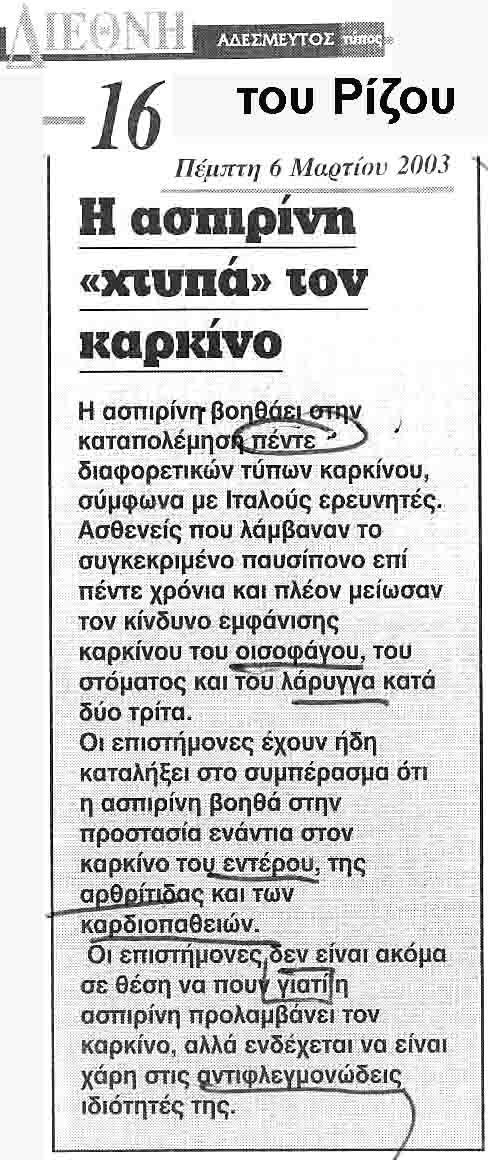
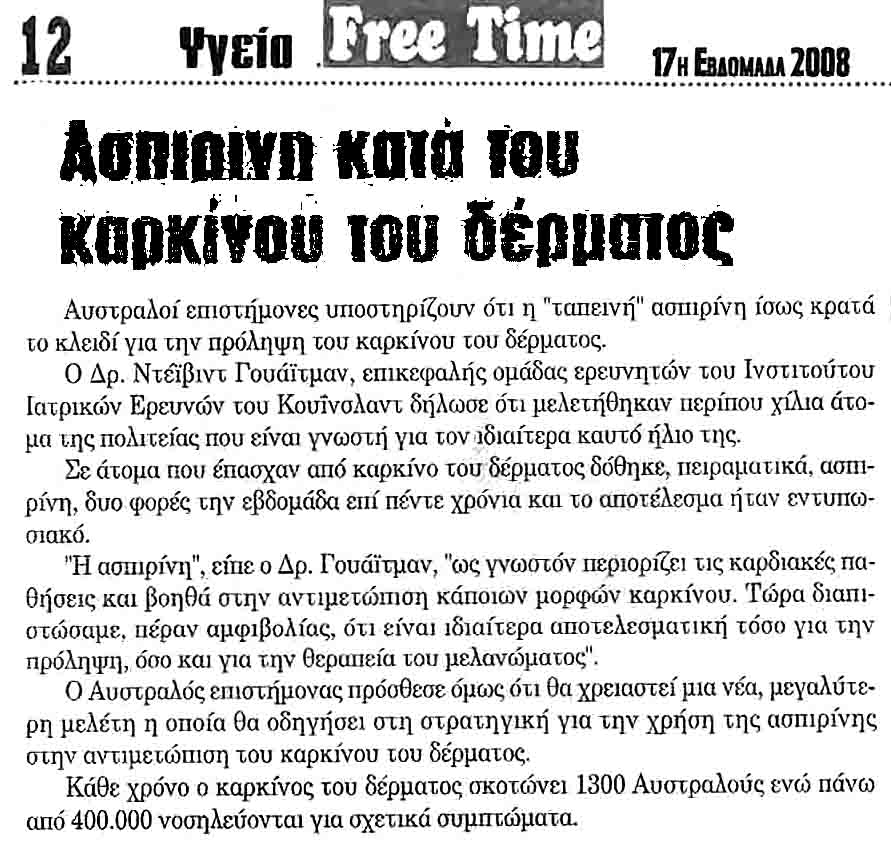
http://www.tovima.gr/science/medicine-biology/article/?aid=447161
BHMA SCIENCE ΔΗΜΟΣΙΕΥΣΗ:
06/03/2012,
Αεριούχος... ασπιρίνη
εναντίον καρκίνου
Είναι 100.000 φορές πιο ισχυρή από τη συμβατική και δεν συνδέεται με
παρενέργειες
http://www.tovima.gr/science/medicine-biology/article/?aid=443554
BHMA SCIENCE
ΔΗΜΟΣΙΕΥΣΗ: 14/02/2012
Η ασπιρίνη «κόβει» τον δρόμο του
καρκίνου
Ασπιρίνη εναντίον καρκίνου του παχέος εντέρου http://www.tovima.gr/default.asp?
pid=2&ct=33&artId=290682&dt=27/09/2009
__________________________________________________________________________________________________
___________________________________________________
___________________________________________________
OF RELATED INTEREST :
"....... Να θυμίσουμε ότι η φλεγμονή κρύβεται πίσω από πλήθος σύγχρονων ασθενειών, συμπεριλαμβανομένων των καρδιαγγειακών νοσημάτων και ορισμένων νεοπλασιών. " http://tovima.dolnet.gr/print_article.php?e=B&f=15426&m=H03&aa=1
_________________________________________________________________________________________________
http://www.arvo.org/EWEB/arvo/pdf/ARVO_Inflammation_Final_51007.pdf
http://www.aamc.org/research/apr/krensky.pdf
_________________________________________________________________________________________________
New Roadmap Emphasis Areas for 2008 http://nihroadmap.nih.gov/2008initiatives.asp
__________________________________________________________________________________________________
SCIENTIFIC AMERICAN. July 2007
________________________________________________________________________________________________
Useful information about reducing inflammation in your body.
________________________________________________________________________________________________
Annals of the New York Academy of Sciences 928:327-335 (2001)
or CLICK here, for the results of a google search on the matter
________________________________________________________________________________________________
DISCOVER magazine December 2007
__________________________________________________________________
http://www.youtube.com/results?search_query=inflammation&search=Search
__________________________________________________________________
__________________________________________________________________
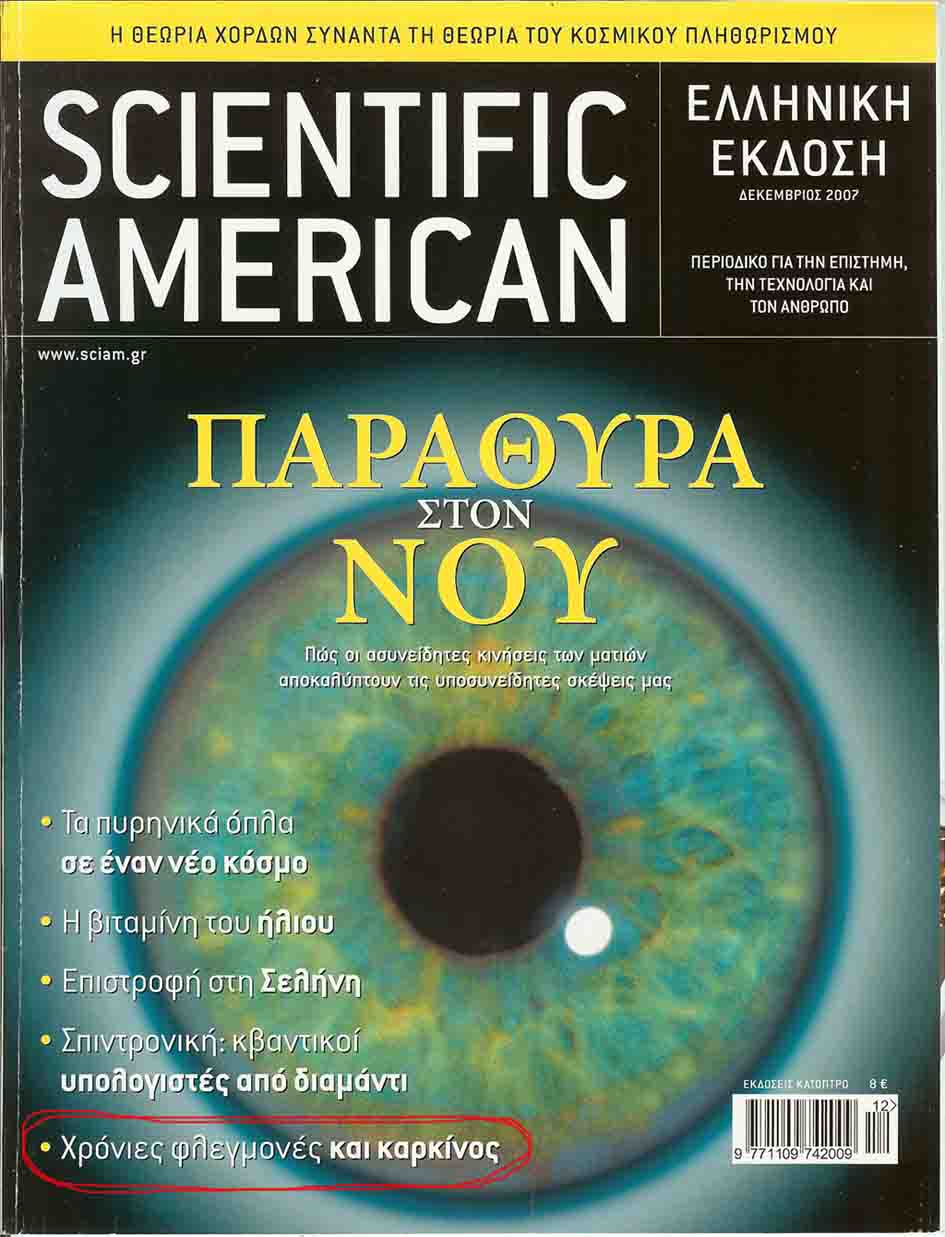 http://www.sciam.gr/topics.asp?action_id=topic_analysis&issue_id=512&topic_id=1169
http://www.sciam.gr/topics.asp?action_id=topic_analysis&issue_id=512&topic_id=1169
Φλεγμονές, ο νέος μυστικός δολοφόνος Συνδέονται άμεσα με καρδιακές προσβολές, καρκίνο και Aλτσχάιμερ http://news.kathimerini.gr/4dcgi/_w_articles_world_1_29/02/2004_95446 clickhere or here